Methylene Blue Release from Chitosan/Pectin and Chitosan/DNA Blend Hydrogels
Abstract
1. Introduction
2. Material and Methods
2.1. Reagents
2.2. Hydrogel Synthesis
2.3. Swelling Kinetic
2.4. Characterization of Hydrogels
2.4.1. Sample Preparation for Characterization
2.4.2. Fourier-Transform Infrared (FT-IR) Spectroscopy
2.4.3. Thermogravimetric Analyzes (TGA)
2.4.4. Scanning Electron Microscopy (SEM)
2.5. Loading of MB by Adsorption
2.6. Adsorption Isotherm Models
2.6.1. Langmuir Isotherm
2.6.2. Freundlich Isotherm
2.6.3. Redlich-Peterson Isotherm
2.6.4. Sips Isotherm
2.7. MB Release Kinetics
2.8. Error Analysis
3. Results and Discussion
3.1. Swelling Kinetics
3.2. Characterization of Hydrogels
3.2.1. Fourier-Transform Infrared (FT-IR) Spectra
3.2.2. Thermogravimetric Analysis
3.2.3. Scanning Electron Microscopy (SEM)
3.3. Methylene Blue (MB) Adsorption Assays
3.3.1. Effects of Dried Hydrogel Mass and Initial MB Concentration
3.3.2. Adsorption Isotherms
3.4. MB Release
4. Conclusions
Author Contributions
Funding
Institutional Review Board Statement
Informed Consent Statement
Data Availability Statement
Acknowledgments
Conflicts of Interest
References
- Liu, H.; Hu, L.; Singh, R.P.; Dave, B.; Chen, J.; Yu, J. Fabrication of a novel drug-resin combination device for controlled release of dextromethorphan hydrobromide. Colloids Surf. B Biointerfaces 2020, 189, 110833. [Google Scholar] [CrossRef]
- Sato, T.; Mello, D.; Vasconcelos, L.; Valente, A.J.M.; Borges, A. Chitosan-Based Coacervate Polymers for Propolis Encapsulation: Release and Cytotoxicity Studies. Int. J. Mol. Sci. 2020, 21, 4561. [Google Scholar] [CrossRef] [PubMed]
- Rashidzadeh, B.; Shokri, E.; Mahdavinia, G.R.; Moradi, R.; Mohamadi-Aghdam, S.; Abdi, S. Preparation and characterization of antibacterial magnetic-/pH-sensitive alginate/Ag/Fe3O4 hydrogel beads for controlled drug release. Int. J. Biol. Macromol. 2020, 154, 134–141. [Google Scholar] [CrossRef]
- Tardivo, J.P.; Del Giglio, A.; De Oliveira, C.S.; Gabrielli, D.S.; Junqueira, H.C.; Tada, D.B.; Severino, D.; De Fátima Turchiello, R.; Baptista, M.S. Methylene blue in photodynamic therapy: From basic mechanisms to clinical applications. Photodiagnosis Photodyn. Ther. 2005, 2, 175–191. [Google Scholar] [CrossRef]
- Vilsinski, B.H.; Souza, P.R.; de Oliveira, A.C.; Filho, C.M.C.; Valente, A.J.M.; Muniz, E.C.; Borges, O.; Gerola, A.P.; Caetano, W.; Martins, A.F. Photophysics and drug delivery behavior of methylene blue into Arabic-gum based hydrogel matrices. Mater. Today Commun. 2020, 26, 101889. [Google Scholar] [CrossRef]
- Simão, A.R.; Fragal, V.H.; Pellá, M.C.G.; Garcia, F.P.; Nakamura, C.V.; Silva, R.; Tambourgi, E.B.; Rubira, A.F. Drug polarity effect over the controlled release in casein and chondroitin sulfate-based hydrogels. Int. J. Biol. Macromol. 2020, 158, 116–126. [Google Scholar] [CrossRef]
- Sun, X.F.; Gan, Z.; Jing, Z.; Wang, H.; Wang, D.; Jin, Y. Adsorption of methylene blue on hemicellulose-based stimuli-responsive porous hydrogel. J. Appl. Polym. Sci. 2015, 132, 19–22. [Google Scholar] [CrossRef]
- Paulino, A.T.; Pereira, A.G.B.; Fajardo, A.R.; Erickson, K.; Kipper, M.J.; Muniz, E.C.; Belfiore, L.A.; Tambourgi, E.B. Natural polymer-based magnetic hydrogels: Potential vectors for remote-controlled drug release. Carbohydr. Polym. 2012, 90, 1216–1225. [Google Scholar] [CrossRef]
- Sood, N.; Bhardwaj, A.; Mehta, S.; Mehta, A. Stimuli-responsive hydrogels in drug delivery and tissue engineering. Drug Deliv. 2016, 23, 758–780. [Google Scholar] [CrossRef] [PubMed]
- Qureshi, D.; Nayak, S.K.; Maji, S.; Anis, A.; Kim, D.; Pal, K. Environment sensitive hydrogels for drug delivery applications. Eur. Polym. J. 2019, 120, 109220. [Google Scholar] [CrossRef]
- Cargnin, M.A.; de Souza, A.G.; de Lima, G.F.; Gasparin, B.C.; Rosa, D.d.S.; Paulino, A.T. Pinus residue/pectin-based composite hydrogels for the immobilization of β-D-galactosidase. Int. J. Biol. Macromol. 2020, 149, 773–782. [Google Scholar] [CrossRef]
- Ishii-Mizuno, Y.; Umeki, Y.; Onuki, Y.; Watanabe, H.; Takahashi, Y.; Takakura, Y.; Nishikawa, M. Improved sustained release of antigen from immunostimulatory DNA hydrogel by electrostatic interaction with chitosan. Int. J. Pharm. 2017, 516, 392–400. [Google Scholar] [CrossRef] [PubMed]
- Kanthasamy, S.; Hadibarata, T.; Hidayat, T.; Alamri, S.A.; Al-Ghamdi, A.A. Adsorption of azo and anthraquinone dye by using watermelon peel powder and corn peel powder: Equilibrium and kinetic studies. Biointerface Res. Appl. Chem. 2019, 10, 4706–4713. [Google Scholar] [CrossRef]
- Pérez-Calderón, J.; Santos, M.V.; Zaritzky, N. Synthesis, characterization and application of cross-linked chitosan/oxalic acid hydrogels to improve azo dye (Reactive Red 195) adsorption. React. Funct. Polym. 2020, 155, 104699. [Google Scholar] [CrossRef]
- Lau, K.B.K.; Hadibarata, T.; Elwina, E.; Dewi, R.; Alsahli, A.A.; Alaraidh, I.A.; Al-Ghamdi, A.A. Reactive dyes adsorption via Citrus hystrix peel powder and Zea mays cob powder: Characterization, isotherm and kinetic studies. Biointerface Res. Appl. Chem. 2019, 10, 4803–4810. [Google Scholar] [CrossRef]
- Martău, G.A.; Mihai, M.; Vodnar, D.C. The Use of Chitosan, Alginate, and Pectin in the Biomedical and Food Sector—Biocompatibility, Bioadhesiveness, and Biodegradability. Polymers 2019, 11, 1837. [Google Scholar] [CrossRef]
- Paulino, A.T.; Simionato, J.I.; Garcia, J.C.; Nozaki, J. Characterization of chitosan and chitin produced from silkworm crysalides. Carbohydr. Polym. 2006, 64, 98–103. [Google Scholar] [CrossRef]
- Aydınoğlu, D.; Ünal, M. Evaluation of the influence of spirulina microalgae on the drug delivery characteristics of genipin cross-linked chitosan hydrogels. Int. J. Polym. Mater. Polym. Biomater. 2019, 68, 1020–1033. [Google Scholar] [CrossRef]
- Morán, M.C.; Infante, M.R.; Miguel, M.G.; Lindman, B.; Pons, R. Novel biocompatible DNA gel particles. Langmuir 2010, 26, 10606–10613. [Google Scholar] [CrossRef]
- Morán, M.C.; Miguel, M.G.; Lindman, B. DNA gel particles: Particle preparation and release characteristics. Langmuir 2007, 23, 6478–6481. [Google Scholar] [CrossRef]
- Ishizuka, N.; Hashimoto, Y.; Matsuo, Y.; Ijiro, K. Highly expansive DNA hydrogel films prepared with photocrosslinkable poly(vinyl alcohol). Colloids Surf. A Physicochem. Eng. Asp. 2006, 284, 440–443. [Google Scholar] [CrossRef]
- Filho, C.M.C.; Bueno, P.V.A.; Matsushita, A.F.Y.; Rubira, A.F.; Muniz, E.C.; Durães, L.; Murtinho, D.M.B.; Valente, A.J.M. Synthesis, characterization and sorption studies of aromatic compounds by hydrogels of chitosan blended with β-cyclodextrin- and PVA-functionalized pectin. RSC Adv. 2018, 8, 14609–14622. [Google Scholar] [CrossRef]
- Crank, J. The Mathematics of Diffusion; Oxford University Press: Oxford, UK, 1975. [Google Scholar]
- Ritger, P.L.; Peppas, N.A. A simple equation for description of solute release II. Fickian and anomalous release from swellable devices. J. Control. Release 1987, 5, 37–42. [Google Scholar] [CrossRef]
- Paulino, A.T.; Belfiore, L.A.; Kubota, L.T.; Muniz, E.C.; Almeida, V.C.; Tambourgi, E.B. Effect of magnetite on the adsorption behavior of Pb(II), Cd(II), and Cu(II) in chitosan-based hydrogels. Desalination 2011, 275, 187–196. [Google Scholar] [CrossRef]
- Langmuir, I. The adsorption of gases on plane surfaces of glass, mica and platinum. J. Am. Chem. Soc. 1918, 40, 1361–1403. [Google Scholar] [CrossRef]
- Vilela, P.B.; Dalalibera, A.; Duminelli, E.C.; Becegato, V.A.; Paulino, A.T. Adsorption and removal of chromium (VI) contained in aqueous solutions using a chitosan-based hydrogel. Environ. Sci. Pollut. Res. 2019, 26, 28481–28489. [Google Scholar] [CrossRef]
- Redlich, O.; Peterson, D.L. A useful adsorption isotherm. J. Phys. Chem. 1959, 63, 1024. [Google Scholar] [CrossRef]
- Sips, R. On the structure of a catalyst surface. J. Chem. Phys. 1948, 16, 490–495. [Google Scholar] [CrossRef]
- Lin, J.; Wang, L. Comparison between linear and non-linear forms of pseudo-first-order and pseudo-second-order adsorption kinetic models for the removal of methylene blue by activated carbon. Front. Environ. Sci. Eng. China 2009, 3, 320–324. [Google Scholar] [CrossRef]
- Ncibi, M.C. Applicability of some statistical tools to predict optimum adsorption isotherm after linear and non-linear regression analysis. J. Hazard. Mater. 2008, 153, 207–212. [Google Scholar] [CrossRef]
- Vareda, J.P.; Valente, A.J.M.; Durães, L. Silica aerogels/xerogels modified with nitrogen-containing groups for heavy metal adsorption. Molecules 2020, 25, 2788. [Google Scholar] [CrossRef] [PubMed]
- Guesser, F. Preparação, Caracterização e Aplicação de Hidrogel de Quitosana/Glutaraldeído; Universidade Federal de Santa Catarina: Florianópolis, Brazil, 2009. [Google Scholar]
- Pereira, A.G.B.; Rodrigues, F.H.A.; Paulino, A.T.; Martins, A.F.; Fajardo, A.R. Recent advances on composite hydrogels designed for the remediation of dye-contaminated water and wastewater: A review. J. Clean. Prod. 2020, 284, 124703. [Google Scholar] [CrossRef]
- Souza, A.G.; Cesco, C.T.; de Lima, G.F.; Artifon, S.E.S.; Rosa, D.d.S.; Paulino, A.T. Arabic gum-based composite hydrogels reinforced with eucalyptus and pinus residues for controlled phosphorus release. Int. J. Biol. Macromol. 2019, 140, 33–42. [Google Scholar] [CrossRef]
- Vieira, R.M.; Vilela, P.B.; Becegato, V.A.; Paulino, A.T. Chitosan-based hydrogel and chitosan/acid-activated montmorillonite composite hydrogel for the adsorption and removal of Pb+2 and Ni+2 ions accommodated in aqueous solutions. J. Environ. Chem. Eng. 2018, 6, 2713–2723. [Google Scholar] [CrossRef]
- De Almeida, D.A. Síntese in situ de Nanopartículas de ouro Para Obtenção de Compósitos com Polissacarídeos Visanddo Aplicações Biomédicas; Universidade Tecnológica Federal do Paraná: Curitiba, Brazil, 2019. [Google Scholar]
- Queiroz, M.F.; Melo, K.R.T.; Sabry, D.A.; Sassaki, G.L.; Rocha, H.A.O. Does the use of chitosan contribute to oxalate kidney stone formation? Mar. Drugs 2015, 13, 141–158. [Google Scholar] [CrossRef]
- Gun’ko, V.; Savina, I.; Mikhalovsky, S. Properties of Water Bound in Hydrogels. Gels 2017, 3, 37. [Google Scholar] [CrossRef]
- Paulino, A.T.; Belfiore, L.A.; Kubota, L.T.; Muniz, E.C.; Tambourgi, E.B. Efficiency of hydrogels based on natural polysaccharides in the removal of Cd 2+ ions from aqueous solutions. Chem. Eng. J. 2011, 168, 68–76. [Google Scholar] [CrossRef]
- Pereira, A.G.B.; Martins, A.F.; Paulino, A.T.; Fajardo, A.R.; Guilherme, M.R.; Faria, M.G.I.; Linde, G.A.; Rubira, A.F.; Muniz, E.C. Recent advances in designing hydrogels from chitin and chitin-derivatives and their impact on environment and agriculture: A review. Rev. Virtual Quim. 2017, 9, 370–386. [Google Scholar] [CrossRef]
- Drozdov, A.D.; Declaville Christiansen, J. Modeling the effects of pH and ionic strength on swelling of polyelectrolyte gels. J. Chem. Phys. 2015, 142, 114904. [Google Scholar] [CrossRef]
- Facin, B.R.; Moret, B.; Baretta, D.; Belfiore, L.A.; Paulino, A.T. Immobilization and controlled release of β-galactosidase from chitosan-grafted hydrogels. Food Chem. 2015, 179, 44–51. [Google Scholar] [CrossRef] [PubMed]
- Martini, B.K.; Daniel, T.G.; Corazza, M.Z.; De Carvalho, A.E. Methyl orange and tartrazine yellow adsorption on activated carbon prepared from boiler residue: Kinetics, isotherms, thermodynamics studies and material characterization. J. Environ. Chem. Eng. 2018, 6, 6669–6679. [Google Scholar] [CrossRef]



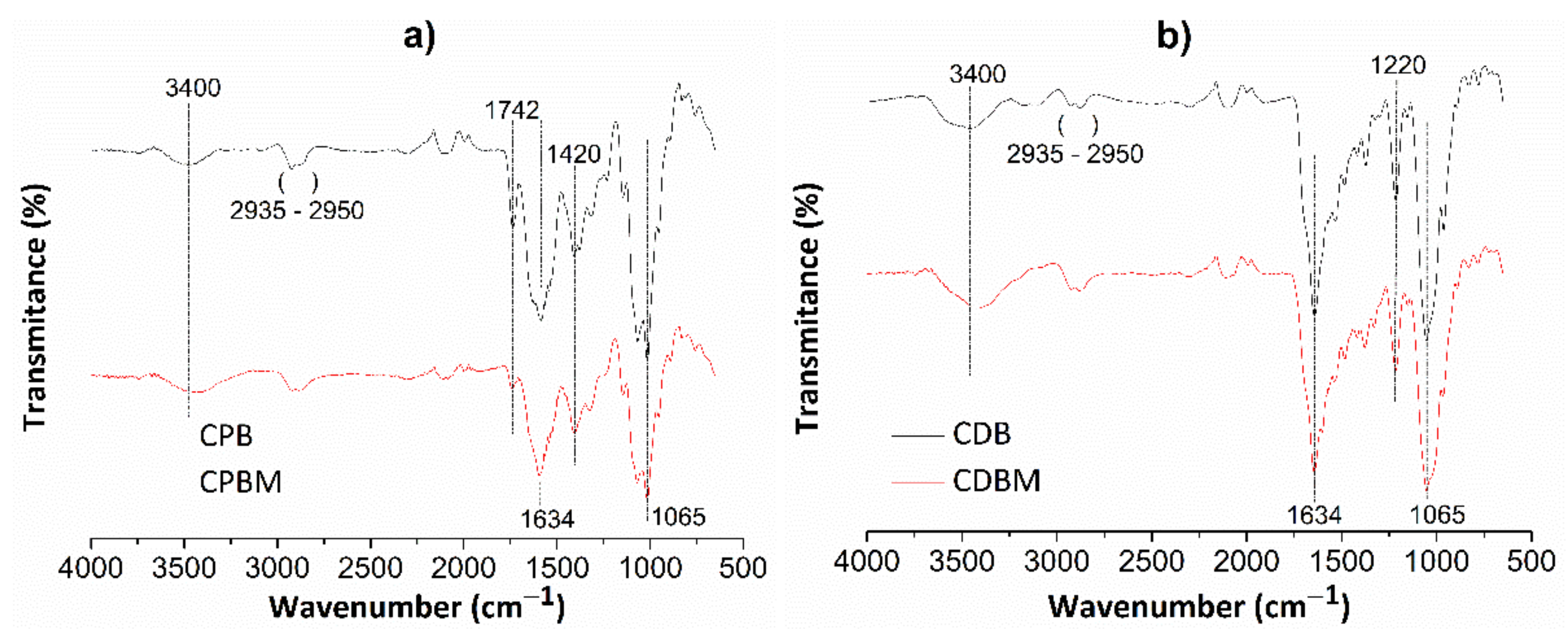
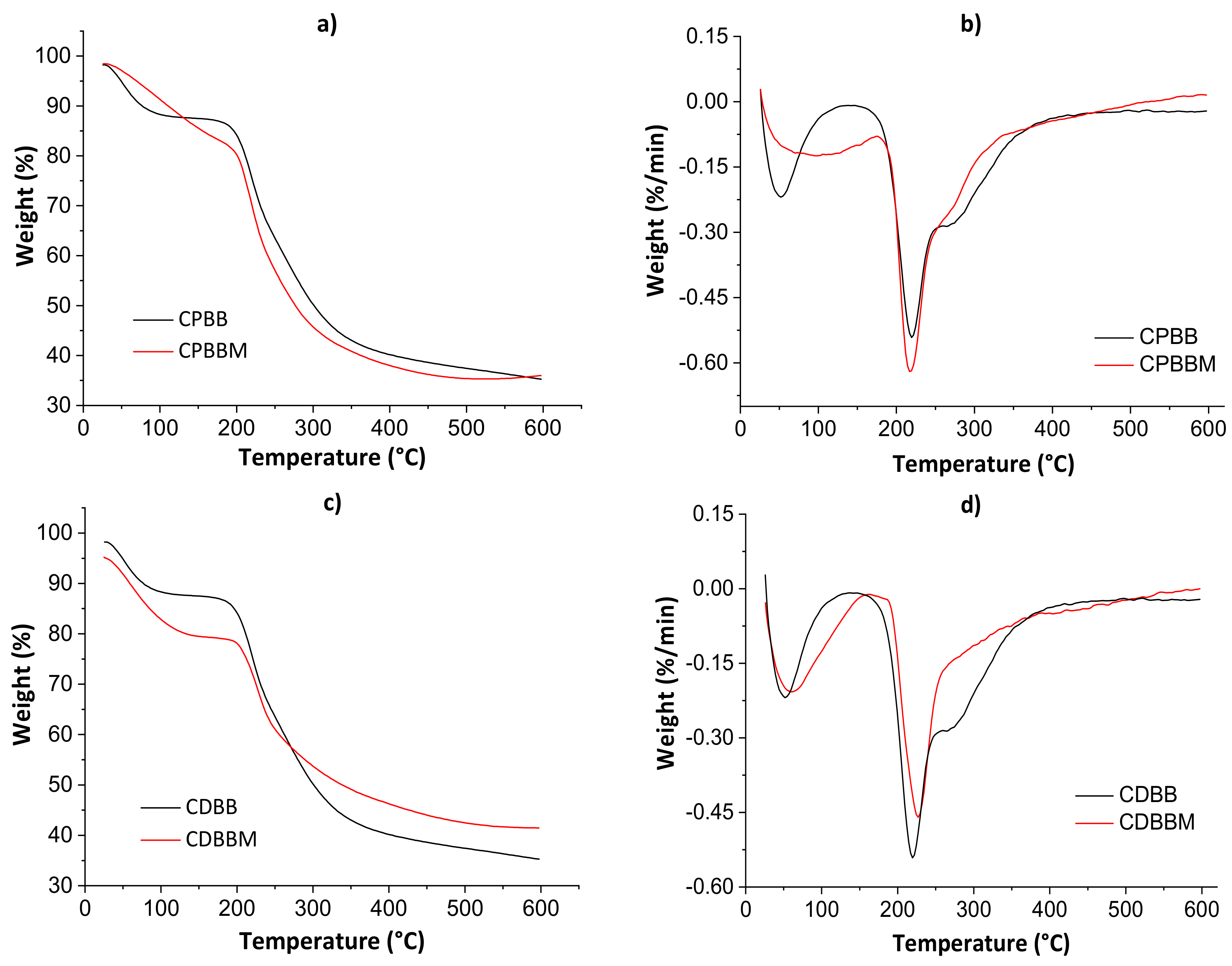

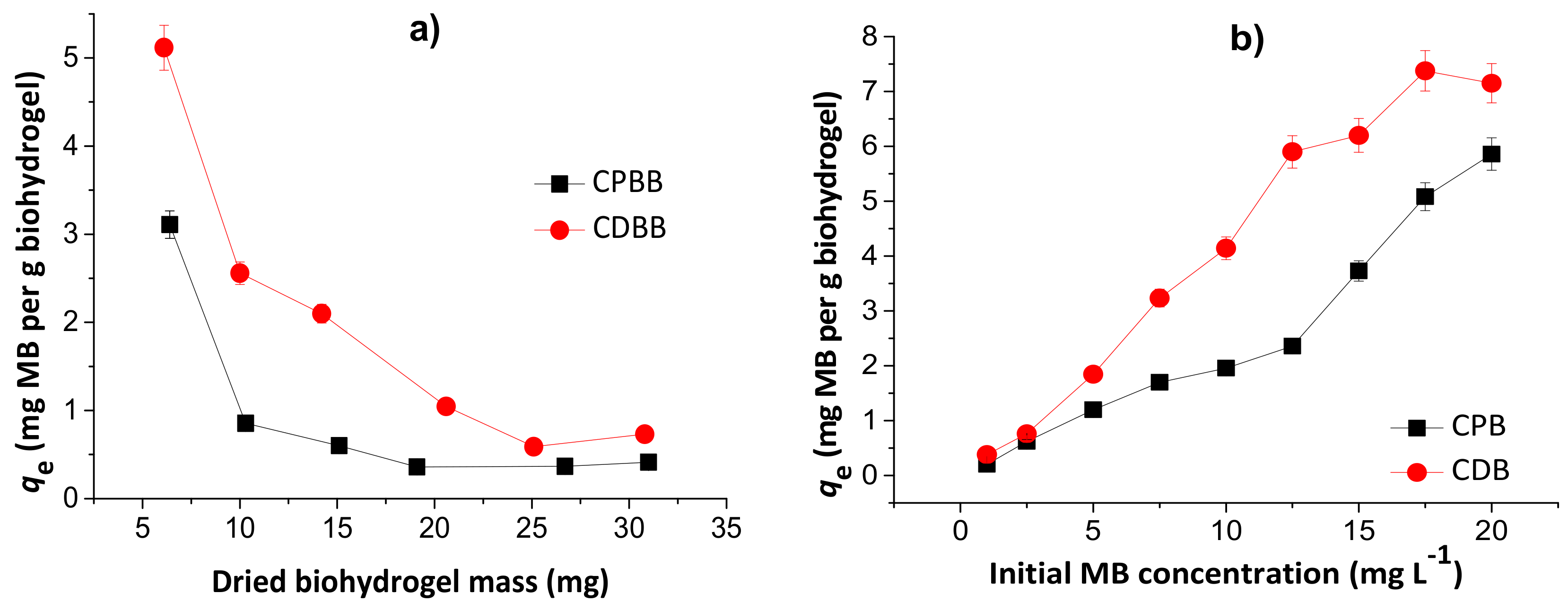

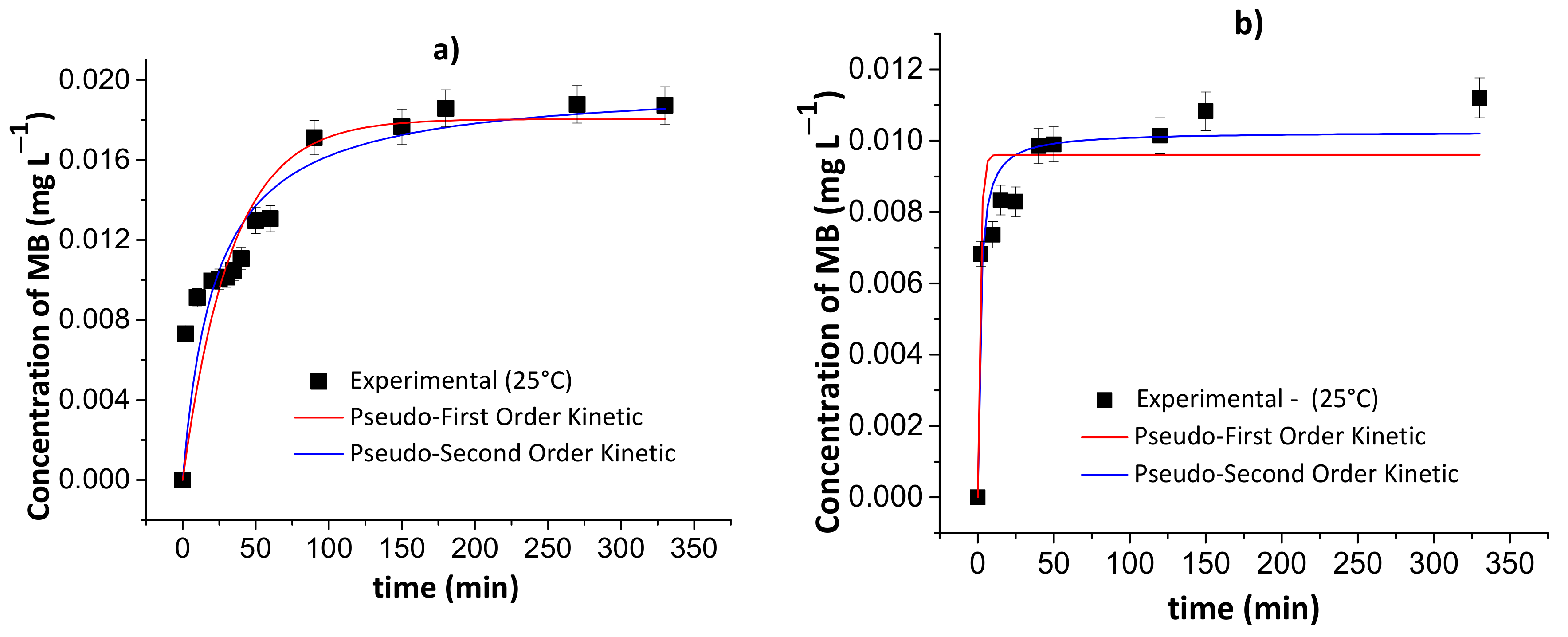

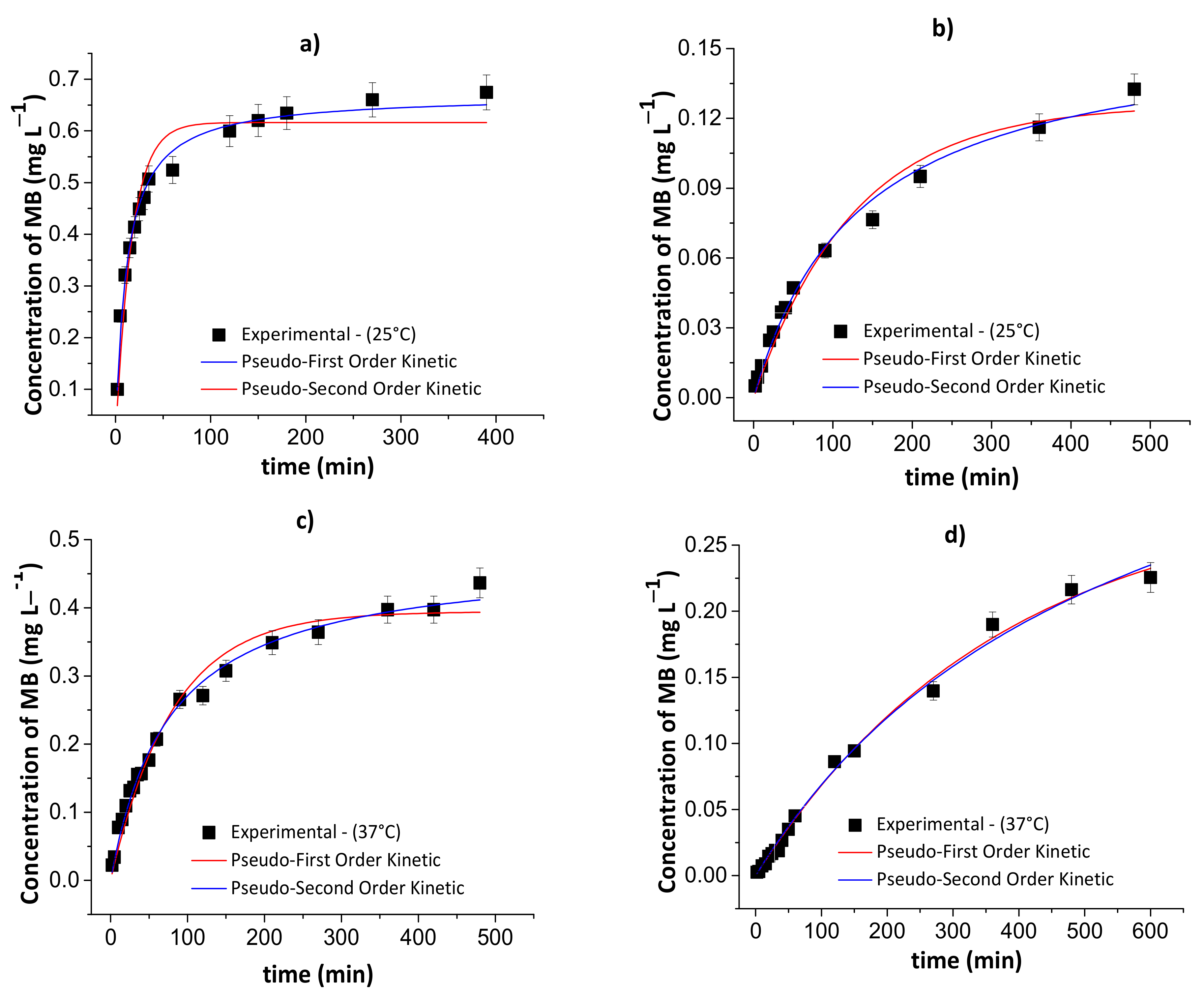
| Hydrogel | Diffusion Exponent (n) | k (min−n) | R² | AIC | |
|---|---|---|---|---|---|
| Ultrapure water | |||||
| CPBB | 0.081 | 0.542 | 0.899 | 3.1 × 10−4 | −26.54 |
| CDBB | 0.323 | 0.126 | 0.956 | 0.002 | −20.36 |
| Simulated physiological fluid | |||||
| CPBB | 0.126 | 0.580 | 0.954 | 1.8 × 10−4 | −17.41 |
| CDBB | 0.379 | 0.271 | 0.923 | 0.002 | −5.761 |
| Simulated gastric fluid | |||||
| CPBB | 0.401 | 0.204 | 0.981 | 7.9 × 10−4 | −16.72 |
| CDBB | 0.370 | 0.086 | 0.999 | 1.7 × 10−5 | −37.74 |
| Simulated intestinal fluid | |||||
| CPBB | 0.097 | 0.680 | 0.928 | 1.5 × 10−4 | −10.61 |
| CDBB | 0.143 | 0.617 | 0.921 | 6.8 × 10−4 | −9.07 |
| Stage | Parameter | CPB | CPBM | CDB | CDBM |
|---|---|---|---|---|---|
| 1st stage | weight (%) | 5.455 | 7.282 | 5.260 | 10.95 |
| Tonset (°C) | 52 | 97 | 52 | 63 | |
| 2nd stage | weight (%) | 13.17 | 18.03 | 12.62 | 21.04 |
| Tonset (°C) | 181 | 190 | 169 | 186 | |
| Tmax (°C) | 220 | 217 | 221 | 229 | |
| Final | Residue (%) | 35.27 | 35.99 | 35.27 | 41.47 |
| Langmuir Isotherm | ||||||
|---|---|---|---|---|---|---|
| Hydrogel | KL (L mg−1) | qmax (mg g−1) | RL | R² | χ2 | AIC |
| CPBB | 5.3 × 10−6 | 116.9 | 0.999 | 0.892 | 0.478 | 2.73 |
| CDBB | 0.480 | 11.60 | 0.455 | 0.822 | 1.480 | 6.35 |
| Freundlich Isotherm | ||||||
| KF (mg(n−1)/n L1/ng−1) | n | bF | R² | χ2 | AIC | |
| CPBB | 0.343 | 0.698 | 1.432 | 0.940 | 0.268 | 0.97 |
| CDBB | 3.657 | 1.912 | 0.523 | 0.755 | 0.956 | 7.47 |
| Redlich-Peterson Isotherm | ||||||
| αR-P (mg−1) | KR-P (L g−1) | βR-P | R² | χ2 | AIC | |
| CPBB | 0.061 | 0.470 | 0.969 | 0.951 | 0.215 | 0.30 |
| CDBB | 0.022 | 3.823 | 0.121 | 0.885 | 0.956 | 4.21 |
| Sips Isotherm | ||||||
| βS | KS (L mg−1) | qms (mg g−1) | R² | χ2 | AIC | |
| CPBB | 1.256 | 0.003 | 188.6 | 0.941 | 0.263 | −1.46 |
| CDBB | 4.398 | 1.648 | 7.264 | 0.967 | 0.271 | −0.18 |
| Model | k1 (min−1) | k2 (L mg−1min−1) | R² | χ² | AIC |
|---|---|---|---|---|---|
| Simulated gastric fluid (25 °C) | |||||
| Pseudo-first-order | 0.0301 | - | 0.793 | 5.64 × 10−6 | −73.66 |
| Pseudo-second-order | - | 2.267 | 0.848 | 4.14 × 10−6 | −75.68 |
| Simulated intestinal fluid (25 °C) | |||||
| Pseudo-first-order | 0.604 | - | 0.820 | 2.02 × 10−6 | −51.74 |
| Pseudo-second-order | - | 57.769 | 0.889 | 1.24 × 10−6 | −54.02 |
| Simulated gastric fluid (37 °C) | |||||
| Pseudo-first-order | 0.024 | - | 0.891 | 2.75 × 10−6 | −67.24 |
| Pseudo-second-order | - | 1.818 | 0.907 | 2.34 × 10−6 | −68.15 |
| Simulated intestinal fluid (37 °C) | |||||
| Pseudo-first-order | 0.067 | - | 0.881 | 1.41 × 10−6 | −59.32 |
| Pseudo-second-order | - | 10.919 | 0.949 | 5.98 × 10−7 | −63.42 |
| Model | k1 (min−1) | k2 (L mg−1min−1) | R² | χ² | AIC |
|---|---|---|---|---|---|
| Simulated gastric fluid (25 °C) | |||||
| Pseudo-first-order | 0.059 | - | 0.927 | 0.002 | −32.40 |
| Pseudo-second-order | - | 0.129 | 0.987 | 3.76 × 10−4 | −42.87 |
| Simulated intestinal fluid (25 °C) | |||||
| Pseudo-first-order | 0.008 | - | 0.975 | 4.28 × 10−5 | −51.74 |
| Pseudo-second-order | - | 0.047 | 0.989 | 1.82 × 10−5 | −56.55 |
| Simulated gastric fluid (37 °C) | |||||
| Pseudo-first-order | 0.013 | - | 0.973 | 4.58 × 10−4 | −58.36 |
| Pseudo-second-order | - | 0.028 | 0.991 | 1.52 × 10−4 | −67.48 |
| Simulated intestinal fluid (37 °C) | |||||
| Pseudo-first-order | 0.003 | - | 0.995 | 2.78 × 10−5 | −72.385 |
| Pseudo-second-order | - | 0.004 | 0.995 | 3.35 × 10−5 | −71.00 |
Publisher’s Note: MDPI stays neutral with regard to jurisdictional claims in published maps and institutional affiliations. |
© 2021 by the authors. Licensee MDPI, Basel, Switzerland. This article is an open access article distributed under the terms and conditions of the Creative Commons Attribution (CC BY) license (https://creativecommons.org/licenses/by/4.0/).
Share and Cite
Cesco, C.T.; Valente, A.J.M.; Paulino, A.T. Methylene Blue Release from Chitosan/Pectin and Chitosan/DNA Blend Hydrogels. Pharmaceutics 2021, 13, 842. https://doi.org/10.3390/pharmaceutics13060842
Cesco CT, Valente AJM, Paulino AT. Methylene Blue Release from Chitosan/Pectin and Chitosan/DNA Blend Hydrogels. Pharmaceutics. 2021; 13(6):842. https://doi.org/10.3390/pharmaceutics13060842
Chicago/Turabian StyleCesco, Cassiele T., Artur J. M. Valente, and Alexandre T. Paulino. 2021. "Methylene Blue Release from Chitosan/Pectin and Chitosan/DNA Blend Hydrogels" Pharmaceutics 13, no. 6: 842. https://doi.org/10.3390/pharmaceutics13060842
APA StyleCesco, C. T., Valente, A. J. M., & Paulino, A. T. (2021). Methylene Blue Release from Chitosan/Pectin and Chitosan/DNA Blend Hydrogels. Pharmaceutics, 13(6), 842. https://doi.org/10.3390/pharmaceutics13060842








